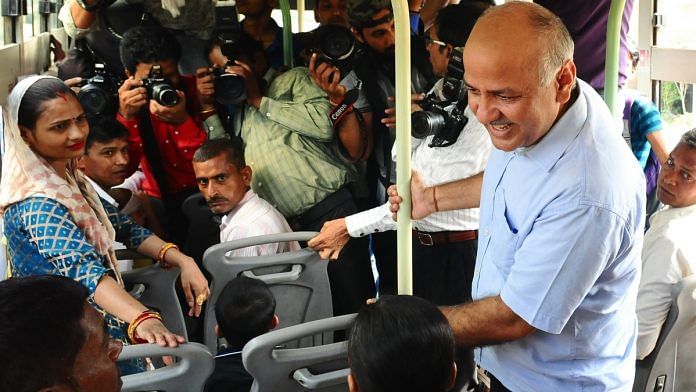The Arvind Kejriwal government’s decision to make public transport free for women in Delhi has been questioned for its financial prudence, given the already stressed public transport finances. To obviate this, the government will give Rs 10 to public transport operators for every ‘pink ticket’ issued to a woman commuter. This may not be sufficient to make the scheme financially sustainable, if fares are the only source of revenue. The situation can change significantly if alternative sources are explored. Lessons need to be drawn from other countries like the United States, France and Colombia for strengthening public transportation finances.
Governments could decide to make public transport entirely free if it serves a larger purpose, but they must first find the resources to sustain the operation and for the long-term. Here, it is important to differentiate between ‘users’ and ‘beneficiaries’ of a public transport system.
The financial side
The Kejriwal government’s move aims to empower women by providing easier access to employment, improving their ability to work further away from home, and promoting safe commute simply by encouraging more women to take public transport.
If women feel secure, it will allow them to supplement their family income and explore more job opportunities. Indeed, the objective of the scheme is laudable.
Operating a public transport system is expensive and if a comprehensive financial mechanism is not available, the system could run the risk of failing. How much it costs depends on several technical parameters like the technology adopted, the vehicle’s maintenance, the crew’s training, and so on. As against this, the funding is ultimately a public policy issue, and depends on the fund’s source in the government.
Also read: Delhi govt ties up with Harvard, World Bank to study impact of free bus rides for women
Users & beneficiaries
‘Users’ are those who use the public transportation system, namely, the daily commuters travelling for work or other purposes. On the other hand, ‘beneficiaries’ are those who benefit from the system. They include the ‘users’, and all those who gain from the existence of public transport in their vicinity. For example, people who own property near a metro station might see an increase in the value of their property; personal motor vehicle users, who would encounter reduced congestion on the roads; and even employers, who are able to run their businesses only because their employees can access work using public transport. These citizens may not necessarily be ‘users’ of the mass-transit system, but they gain from it and become ‘beneficiaries’.
We currently tend to look at the ‘users’ as the only beneficiaries of public transport, and hence think that the system has to be kept financially sustainable only through fares – that is, by the users paying for it. However, if all ‘beneficiaries’ are mandated to pay for the services, then the issue of financial sustainability is easily taken care of.
Also read: Delhi Metro chief says free rides for women not possible until tech updated to check misuse
An untapped model
Several global practices could show us the way to develop a judicious, well-devised payment structure to fund public transport operations.
France charges a small percentage of the wage bill as transportation taxes from all employers – the country’s total public transport expense is €16.5 billion, of which 30 per cent is publicly funded, 30 per cent by direct users, and the remaining 40 per cent is acquired from indirect beneficiaries.
The US federal government levies a gasoline tax of 18 cents-a-gallon and uses part of this collection towards public transport operations. Colombia levies a land-value tax on people owning property near mass-transit systems as compensation for the benefits reaped by simply being in the vicinity.
Drawing lessons from these, Delhi should explore options to tap resources from the beneficiaries, who may not be the primary users of public transport but benefit from it nonetheless in multiple ways.
Also read: 5 years on, Arvind Kejriwal magic has waned. But he is still the alternative Indians want
Dues and bureaucratic red-tape
Indeed, the Arvind Kejriwal government’s idea of compensating for the loss of income faced by the public transport operators by collecting a voluntary Rs 10 payment on each ‘pink ticket’ does help ease the concern about the scheme’s financial sustainability. But the larger issue remains that it is not easy to collect reimbursement from the government, and public transport operators will often be required to run from pillar to post to receive their due.
Officials who ultimately approve the operators’ bills remain worried about political ramifications and the otherwise avoidable scrutiny into accounting and book-keeping processes. As a result, they tend to safeguard themselves by seeking multiple approvals before releasing the payments to the operators. The delay in settling the operators’ bills demotivates them and the spate of action that results from being held responsible for that delay does not help the case either.
The Aam Aadmi Party government would do well to put in place a mechanism that insulates the public transport operators from the bureaucratic red-tape of securing payments. This will go a long way in easing the criticism against free public transport use for women, which is otherwise a laudable initiative.
The author is CEO, WRI India, and an expert in urban transport. Views are personal.







There are homes where there is a car for each person, sometimes even more. Levy congestion tax on them, especially luxury vehicles, 5 percent of their market value, every year.
Guess, it must be cultural differences. In US a house loses value if near the airprt or metro station. Noise trups these. People hate car pooling even if it saves them $. Finally no govt dares to tell you what you do on your own for your own benefit. The invaded bedroom peeping toms were quashed for moving against gay sex between consenting adults. Oh, and we have miles to go.